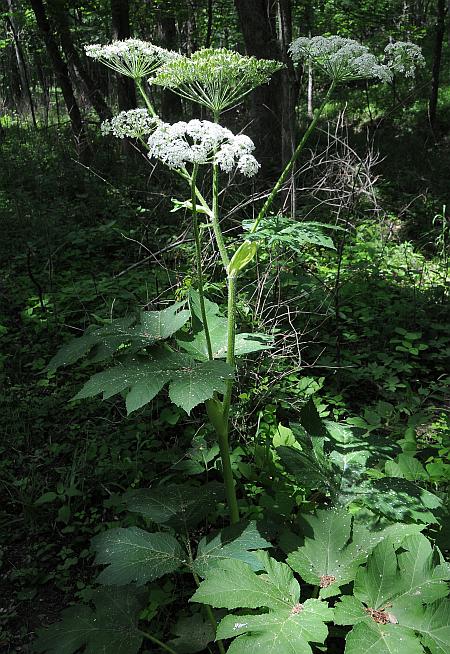Heracleum sphondylium L.
Cow Parsnip

Native
CC = 6
CW = 0
MOC = 12
© SRTurner
Heracleum sphondylium L.Cow Parsnip | |
 |
Native CC = 6 CW = 0 MOC = 12 |
© SRTurner |
|
Family - Apiaceae Habit - Taprooted perennial forb. Stem - Erect, stout, ridged, to 2 m, sparsely to densely pubescent with spreading hairs.
Leaf - Alternate and usually basal, petiolate. Petioles densely pubescent, with base sheathing and strongly inflated. Blades broadly ovate to circular in outline, lobed or ternately compound, pubescent, toothed on margins.
Inflorescence - Terminal and axillary compound umbels. Involucre of 5-10 bracts to 2 cm long, hairy, deciduous. Rays numerous, 5-10 cm long, unequal in length, hairy. Involucel of 4-10 bractlets, hairy.
Florets - Numerous in each umbellet, on stalks to 12 mm long. Petals obovate, white, sometimes larger near edge of umbellet. Ovaries hairy.
Fruits - To 12 mm long, oblong-obovate, flattened, sparsely hairy, tan with darker oil tubes between ribs.
Flowering - May - July. Habitat - Bottomland forests, ravines. Origin - Uncertain. Lookalikes - None. Other info. - This coarse, giant plant is uncommon in Missouri, found in only a few widely scattered counties. It is more common elsewhere and is found in most U.S. states, except for the far south. It is quite common in some areas, e.g. in portions of the Rockies. The plant is easily recognized by its large, coarse stems with greatly distended petiole sheaths, and giant compound umbels of white florets. The gigantic stature and coarse nature often attained by these plants make the term "cow parsnip" seem somehow appropriate. Photographs taken at Shaw Nature Reserve, Franklin County, MO, 5-25-2014 and 6-20-2014 (SRTurner). |